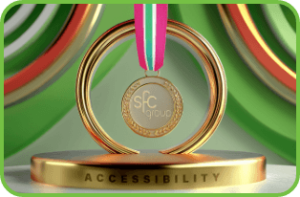ONE MORE THOUGHT
Insights @Work, Life, and Work Life

Who Does Web Accessibility Benefit? (Hint: the Answer Is Everybody)
Picture this: It’s a beautiful sunny day, and you decide to take your work to the back patio. You gather your laptop, a refreshing iced coffee, and your trusty dog, ready to conquer the workday.
But wait! Your plan is foiled by the bright sun and a not-so-bright laptop screen. And because the website you’re perusing isn’t accessible, you can’t see the words on the screen.
Now, imagine this: An accessible website with perfect contrast ratios. Suddenly, the text is clear, the sun is your friend, and your workday is saved.
This scenario is just one of many where web accessibility benefits everyone. Web accessibility, which is when sites are designed and coded to help people with disabilities, also benefits people without disabilities. Whether you’re new to web accessibility or a seasoned pro, here’s a quick recap of what it is and who it benefits.
The web is for everyone…right?
The “World Wide Web” may feel like it’s been around forever, but it only came about a few decades ago, in 1993. It dramatically changed the way humans communicated, making endless amounts of information (like cat videos and questionable life hacks) available with the click of a few buttons.
Tim Berners-Lee, the inventor of the web, proudly touted the web’s inclusivity by saying, “The power of the web is in its universality. Access by everyone regardless of disability is an essential aspect.” In many ways, this was true. People with disabilities – whether auditory, cognitive, physical, neurological, visual, or speech-related – don’t always face the same barriers on the web that they do in the physical world.
But when websites are poorly designed, this vision falls to shambles.
Web accessibility is critical to creating high-quality websites that everyone can use. In doing so, not only are you ensuring access to your products and services, but it’s also the morally just thing to do.
Benefit 1: mastering the art of small screens
Is it just us, or do screens keep getting smaller and smaller? While devices like smartphones and smartwatches are convenient, they can make it harder to see what’s on the screen. Reading your work emails might feel like decoding the fine print on a new terms of service agreement that you definitely read through in its entirety.
Web accessibility makes using small screens less challenging. For instance, if a user zooms in on text, a responsive site will rearrange itself accordingly. This makes the text easier to read on those emails that you surely wanted to read in the first place.
Benefit 2: bridging the generational tech gap
If you’ve ever helped a parent or grandparent use technology, you know they sometimes struggle. Whether the text is difficult to read, the buttons are hard to press, the audio is hard to hear, or they get distracted with all the chaos on the page, it can be quite the challenge.
And with an increasingly older population in the US, more and more of your target audience will fit in this age group in the years ahead.
Web accessibility helps these users access the information they need. From avoiding information overload to using color, space, and contrast properly, accessible websites help older users surf the web in its entirety without all the unnecessary hurdles.
Benefit 3: dealing with life (and broken bones)
Life is notoriously unpredictable. While you might not think you’d break your arm trying to recreate a viral dance, it could happen – and you may end up struggling to surf the web (and more dance videos) as a result.
Whether it’s a broken bone or another temporary disability, there are plenty of reasons you might struggle to navigate a website. For instance, that broken arm could force you to rely on your nondominant hand, making buttons and navigation menus suddenly feel impossible.
Thanks to web accessibility, like easy to press buttons and keyboard navigation, you can continue surfing the web without issue (we might suggest searching for more, ahem, novice dance moves).
Benefit 4: adjusting to situational curveballs
Physical injuries and limitations aren’t the only curveballs life might throw at you. Sometimes it’s sunlight that turns your screen into a mirror (😬), a noisy environment that feels like a rock concert (🙉), or a location where blasting audio is a big no-no (🤫).
Without accessibility, certain features of the site might be suddenly off-limits. For instance, a noisy room might make videos impossible to hear. Enter captions and text transcripts, swooping in like superheroes, making the impossible possible once again.
Benefit 5: surviving the Wi-Fi woes
We’re not here to start problems, but there are one or two internet service providers out there that seem to be particularly…unreliable. If you’re among the unfortunate ones to rely on their service, you’ve felt the pain of slow bandwidth. This can make it challenging if not impossible to use the internet.
Certain web accessibility approaches can reduce bandwidth use and server load. This can offset the challenges and headaches caused by slow internet speeds. (You’re welcome, internet companies.)

Winning gold in web accessibility
There’s no question that designing your website with web accessibility in mind is beneficial to everyone’s user experience and your site’s success. The goal is to do so effectively.
While there are plenty of resources available about web accessibility, you may want to pass the torch to the experts. At SFC Group, we’re champions of website design, including accessibility. Whether your site is brand spanking new or has been around the track a time or two, we’ll ensure everything about your site meets accessibility standards, user needs, and your unique goals.
Want to elevate your user experience and accessibility? We’ve got you covered. Drop us a line, and we’ll get the ball rolling.
